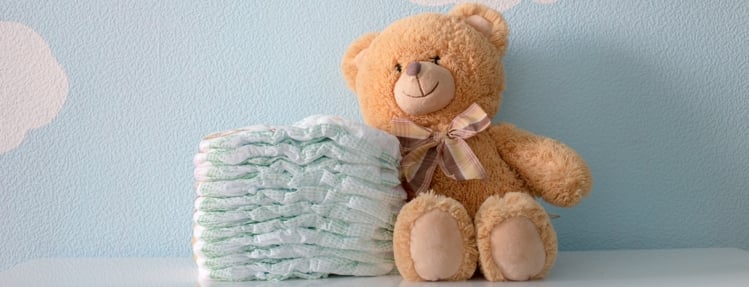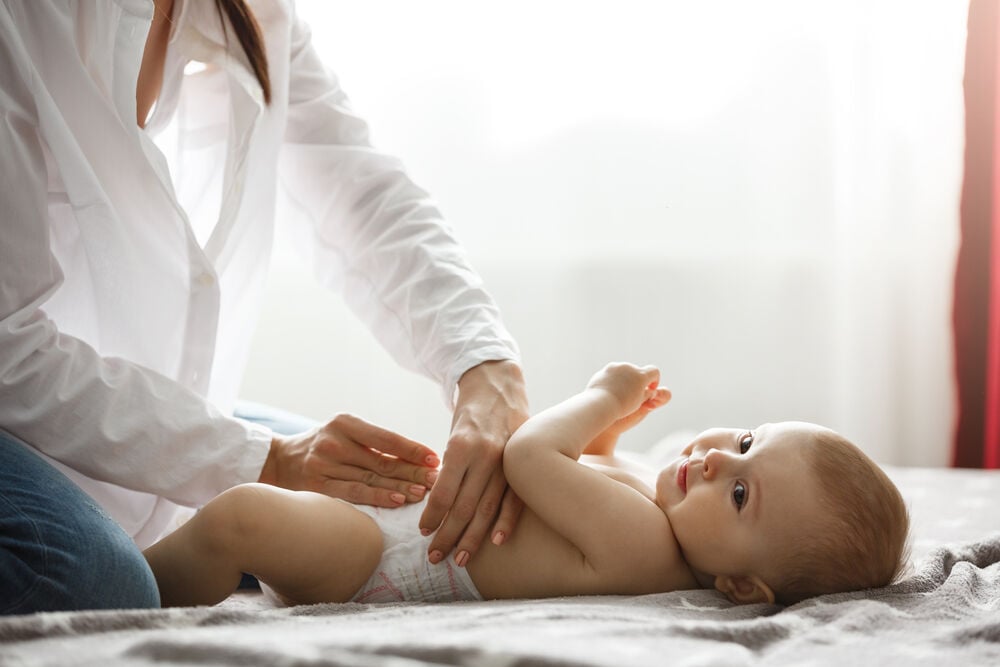Diapers are a useful invention and make parents’ lives much easier. But new parents may be wondering: How many diapers does a newborn use a day? Learn the answer and all about newborn diaper sizes in the following article.
-
Tracking cycle
-
Getting pregnant
-
Pregnancy
-
Help Center
-
Flo for Partners
-
Anonymous Mode
-
Flo app reviews
-
Flo Premium New
-
Secret Chats New
-
Symptom Checker New
-
Your cycle
-
Health 360°
-
Getting pregnant
-
Pregnancy
-
Being a mom
-
LGBTQ+
-
Quizzes
-
Ovulation calculator
-
hCG calculator
-
Pregnancy test calculator
-
Menstrual cycle calculator
-
Period calculator
-
Implantation calculator
-
Pregnancy weeks to months calculator
-
Pregnancy due date calculator
-
IVF and FET due date calculator
-
Due date calculator by ultrasound
-
Medical Affairs
-
Science & Research
-
Pass It On Project New
-
Privacy Portal
-
Press Center
-
Flo Accuracy
-
Careers
-
Contact Us
How Many Diapers a Day Does a Newborn Use?

Every piece of content at Flo Health adheres to the highest editorial standards for language, style, and medical accuracy. To learn what we do to deliver the best health and lifestyle insights to you, check out our content review principles.
How many diapers do you need for a newborn?
The number of diapers a baby goes through is a good indicator of whether they’re getting enough to eat and are sufficiently hydrated. Fewer wet diapers may indicate dehydration, and fewer poopy diapers may result from constipation, low milk supply, or other digestive issues.
For the initial few days after delivery, the total number of diapers they will wet generally increases every passing day. How many diapers per day for a newborn baby is necessary? By the time a baby is five days old, they may pass urine about six times per day and have about three or more stools per day. For the first few weeks, a newborn baby may need up to 10 to 12 diapers a day.
As the baby grows older, their need for diapers tends to decrease.
Generally, one good indication that the baby is getting enough nutrition is if there are six to eight wet diapers per day.

Babies need their diapers changed every time they pass urine or stool or at least every two to three hours.
How often a baby needs their diaper changed also depends on how sensitive their skin is. The skin of some newborns is very delicate, and they may need a new diaper every time they pee to keep their skin from becoming red and sore. It’s important to change a baby’s diaper as soon as possible after they have pooped.
Changing diapers less frequently may lead to yeast infections and diaper rashes.
Take a quiz
Find out what you can do with our Health Assistant
How to change a diaper
Before beginning to change a baby’s diaper, it’s worth remembering that some newborn babies sometimes pee immediately on exposure to open air. Keep them covered while changing the diaper to avoid a mess.
A newborn baby is usually cooperative for about four months. For babies that age or younger, first lift their legs using one hand and put a clean diaper beneath their bottom using the other hand. Now unfasten their old diaper, wiping their bottom with the diaper’s inner side while removing it.
Then wipe their bottom and the surrounding areas using a baby wipe, washcloth, or moist tissue. Now remove the soiled diaper and the used wipes from beneath the baby and keep them in a safe place.
While putting on a new diaper, ensure that the diaper’s front portion is placed between their legs and at the same level as at the back, generally around the belly button level. Check to ensure that the diaper tabs are secured evenly in the front and no gaps are present around their hips. Moreover, ensure that the edge around their legs doesn’t get tucked in the elastic edges of the diaper. This helps prevent leaks. Before the umbilical cord falls off, keep the front of the diaper folded below the cord.
How to choose diapers
Another important question is which type of diaper to choose for the baby. Both cloth and disposable diapers are available in a variety of sizes and shapes. The choice may be confusing initially; however, with continuous use, it may become clearer which diapers suit the baby best.
Cloth and disposable diapers have advantages and disadvantages regarding convenience, cost, and their effects on the environment.
For instance, disposable diapers are convenient, but cloth diapers are cheaper over the long term. Moreover, both disposable and cloth diapers have effects on the environment including energy and raw material usage, water and air pollution, and disposal of waste. Disposable diapers make up about 1 to 2 percent of solid waste, whereas cloth diapers utilize more water and energy in washing and add to water and air pollution.
While making the choice, there are also certain health aspects to consider. Diaper rash can result from contact with stool and urine for excessive amounts of time. Since cloth diapers aren’t able to keep the baby’s skin dry, it’s imperative to change them quickly once they become soiled or wet. Ultimately, it’s the parents’ own decision about which diaper to choose based on their own needs and concerns.
Newborn diaper sizes
To determine the right newborn diaper size, opt for the larger-sized diaper if the baby is between sizes. If the baby’s skin is red, irritated, or marked because of the elastic of the leg openings poking into their legs or waist, or it’s difficult to close the diaper over their belly, it may be time to change the size of the diaper.
An ideal indication of a correct newborn diaper size is when two fingers fit between the baby’s belly and the waistband of the diaper and one finger between the leg elastic and the baby’s leg. A leaking diaper is another indicator of a need for a larger-sized diaper.
Summary
Diapers are a useful invention and make life easier for new parents. Lots of people wonder: How many diapers does a newborn use? For the initial few weeks, a newborn baby may need about 10 diapers a day. As they grow older, their need for diapers decreases. By the time they become five months old, they may need about six diapers a day.


Hey, I'm Anique
I started using Flo app to track my period and ovulation because we wanted to have a baby.


The Flo app helped me learn about my body and spot ovulation signs during our conception journey.


I vividly
remember the day
that we switched
Flo into
Pregnancy Mode — it was
such a special
moment.
Real stories, real results
Learn how the Flo app became an amazing cheerleader for us on our conception journey.




